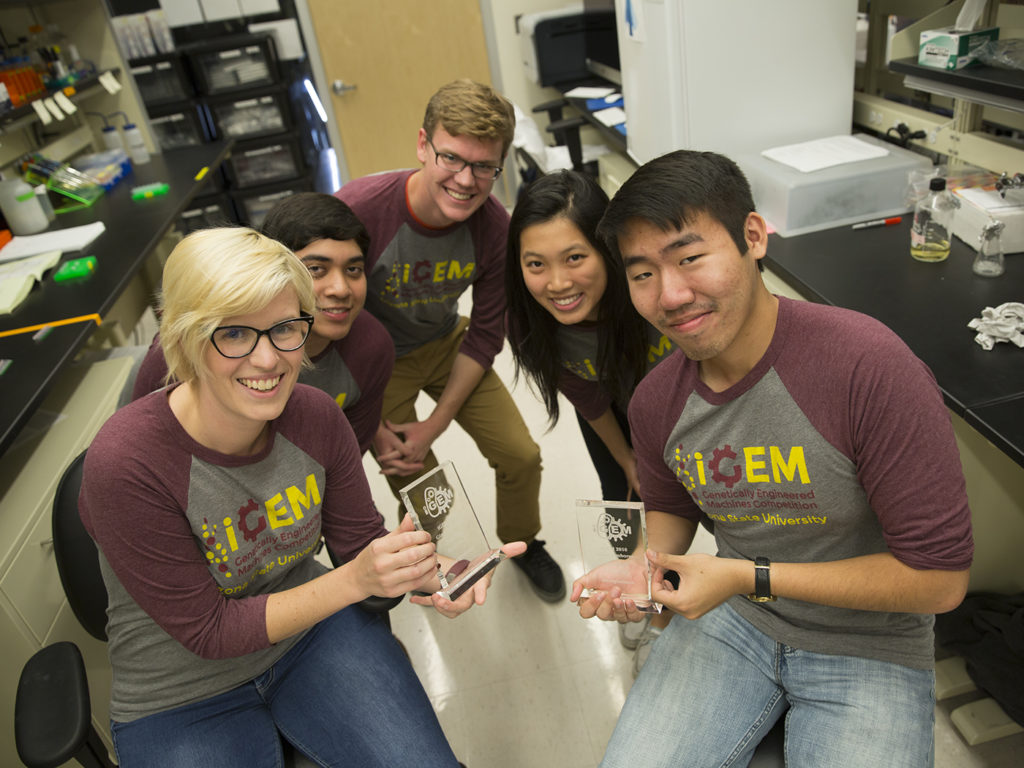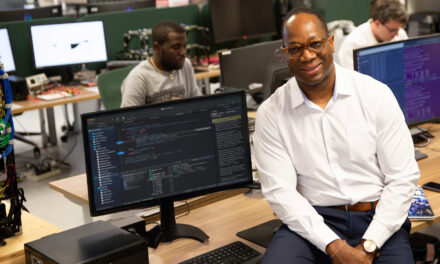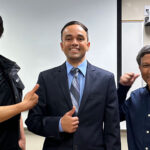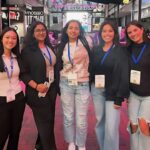
Impressive at iGEM
ASU science and engineering students earned judges’ admiration — and top awards — at international synthetic biology competition

Members of Arizona State University’s iGEM team display some of the awards they earned at this year’s International Genetically Engineered Machine competition. From left to right are student mentor Cassandra Barrett and students Ernesto Luna, Brady Dennison, Jiaqi Wu and Jimmy Xu. Photography: Jessica Hochreiter/ASU
Soon after arriving at the 2016 International Genetically Engineered Machine Giant Jamboree to showcase the project they had worked on for several months, the undergraduate students representing Arizona State University’s iGEM team got a shocking surprise.
Their two graduate student advisors had been mistaken for team members, so the three undergraduates were placed in the graduate level of the iGEM competition instead of the undergraduate level division.
They would be up against more experienced rivals, many of them veterans of iGEM contests.
The three-day competition is the largest and most prominent test of students’ skills in synthetic biology. The fast-emerging field uses advanced cell engineering techniques to develop solutions to major health challenges, as well as new ways to produce energy, fabricate materials and more.
The iGEM event helps to fuel the advancement of synthetic biology with fresh ideas contributed by the undergraduate scientists-in-training.
Students from some of the world’s most prestigious colleges and universities were among the approximately 5,600 students on about 300 teams from 42 countries who came to Boston recently for the annual iGEM gathering.
Brady Dennison, Jiaqi Wu and Jimmy Xu represented the ASU iGEM team this year.
Building with ‘BioBricks’
Dennison is a biomedical engineering major in ASU’s Ira A. Fulton Schools of Engineering and a microbiology major in the School of Molecular Sciences.
Wu and Xu are students in ASU’s Barrett, the Honors College. Wu is a computer science major and Xu is chemical engineering major in the Fulton Schools. Xu is also studying molecular biosciences in the School of Life Sciences.
They went into the competition armed with the results of the team’s project: Diverse Homoserine Lactone Systems for Cellular Communication.
The iGEM competition requires students to carry out comprehensive projects that detail their new synthetic biology system from initial development and wet-bench research to final deployment, including consideration of the anticipated impacts of their new system on society.
The most competitive projects meaningfully explore the biosecurity and policy issues that would be involved in adequately governing the practice of particular kinds of synthetic biology work.
Each team is required to develop and share “BioBricks,” genetic materials that are building blocks for constructing more complex genetic systems.
Bacterial communication systems
The ASU team’s research was based on a genetic system that enables bacteria to communicate with one another using small molecules known as N-Acyl homoserine lactones, or AHLs.

Jimmy Xu (left) and Jiaqi Wu demonstrate some of the lab procedures they performed in conducting research for their team’s iGEM competition project. Photographer: Jessica Hochreiter/ASU
The molecules act as signals that travel from one bacterium to the next, activate genes in the bacteria, and thereby alter cell behaviors within groups of bacteria.
This signaling is called quorum sensing, a term describing how bacteria coordinate the genes that influence their behavior depending upon the density of their population.
The team produced six new BioBricks derived from quorum sensing systems of different species of bacteria. These BioBricks can potentially be used to build complex artificial gene circuits in which each unique signal activates different steps in the circuit.
In real-world environments, synthetic circuits must be able to sense and respond to combinations of conditions. The quorum sensing BioBricks could support complex circuitry, and therefore make synthetic circuits more useful.
In addition, the team’s report looked at the biosafety implications of using homoserine lactones to artificially control bacteria.
Working with nature to solve problems
The project’s outcome definitely opened the door to some ideas for a way to more precisely control communications among bacteria, says the team’s student mentor, Cassandra Barrett, who is pursuing a doctoral degree in biological design in the Fulton Schools.
“What we want is to have a signal that talks only to a specific receiver and not have the message spread out among several receivers,” she explains.
“It’s about discovering how to make natural processes work the way we want them to so we can solve problems,” says team member Ernesto Luna, a biochemistry major in the School of Molecular Sciences.
If communications between bacteria could be better controlled, he says, ‘‘You could make new biosensors. You could have cells that detect signals that are signs of certain diseases.”
Luna produced a substantial amount of the data that the team used in its presentations at the iGEM competition.
ASU’s best iGEM performance
What the students produced together was “fantastic,” says the team’s faculty mentor Karmella Haynes, a synthetic biologist and an associate professor of biomedical engineering.
The competition judges obviously agreed. Even though the undergrads’ work was measured against the projects of grad students, the ASU squad won more awards than any of the four previous teams that have represented ASU at the iGEM event.
The results:
Best New Basic Part award for development of a high-impact DNA fragment that is likely to see wide use in future research.
Best Part Collection award for development of several DNA fragments that can be used for customized engineering.
Biosafety Commendation for the team’s investigation of the impact of small-molecule signals on microbes in the environment. Some of the DNA fragments used to produce those signals were made by the ASU students.
The team was also one of the finalists for the “Best in Track: Foundational Advance” award and the “Best Integrated Human Practices” award.
In addition, the 2016 ASU team was among those that earned the iGEM competition’s Gold Medal for outstanding overall performance in meeting the rigorous criteria of the various aspects of the contest — encompassing both technical achievement and incorporating consideration of societal impacts into project design.
High expectations for next competition
“I was approached by several judges who expressed praise for how well ASU did,” Haynes says, adding that an FBI official told her he was particularly interested in the biosafety concerns the students raised as part of their project.
Their accomplishment inspired Haynes’ confidence in the outlook for the team in 2017.
“Next year we hope to win ‘Best in Track’ and even the coveted BioBrick Trophy for the best project worldwide,” Haynes says.
The students “know a whole lot more about synthetic biology than when they started this project” in the spring, says Barrett. “All that new knowledge will be a springboard for next year’s project.”



































